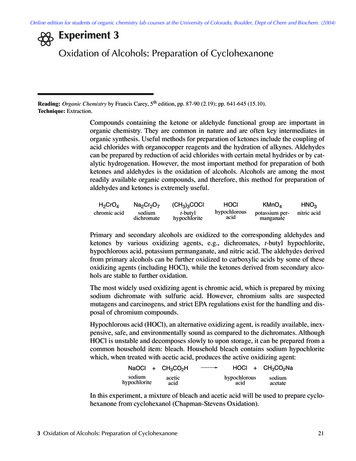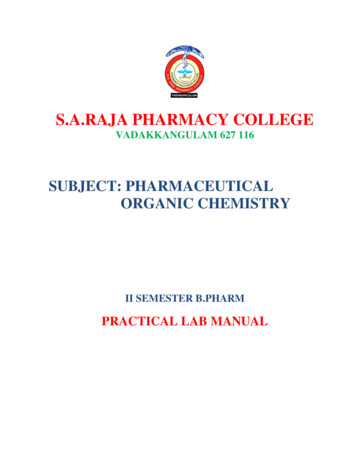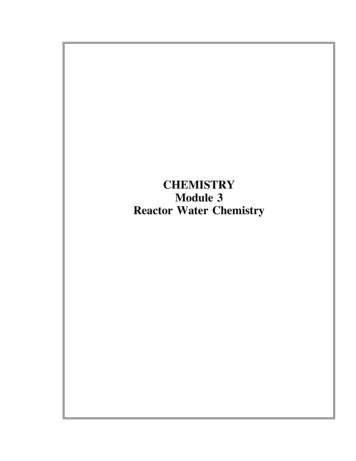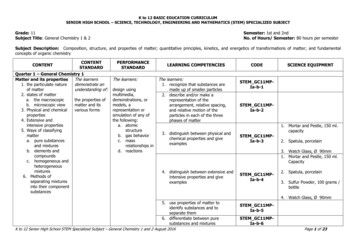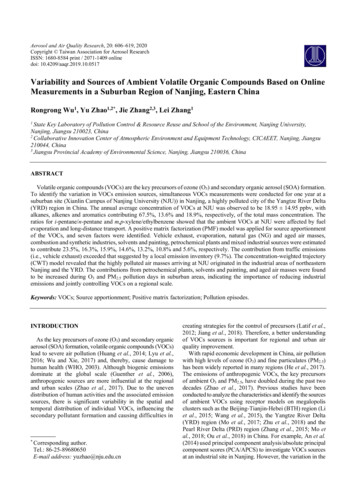
Transcription
(4,5,9,11,12/98)(1,9,10/99)NeumanChapter 1Chapter 1Organic Molecules and Chemical BondingfromOrganic ChemistrybyRobert C. Neuman, Jr.Professor of Chemistry, emeritusUniversity of California, Riversideorgchembyneuman@yahoo.com http://web.chem.ucsb.edu/ neuman/orgchembyneuman/ Chapter Outline of the ****************************************I. Foundations1.Organic Molecules and Chemical Bonding2.Alkanes and Cycloalkanes3.Haloalkanes, Alcohols, Ethers, and Amines4.Stereochemistry5.Organic SpectrometryII. Reactions, Mechanisms, Multiple Bonds6.Organic Reactions *(Not yet Posted)7.Reactions of Haloalkanes, Alcohols, and Amines. Nucleophilic Substitution8.Alkenes and Alkynes9.Formation of Alkenes and Alkynes. Elimination Reactions10.Alkenes and Alkynes. Addition Reactions11.Free Radical Addition and Substitution ReactionsIII. Conjugation, Electronic Effects, Carbonyl Groups12.Conjugated and Aromatic Molecules13.Carbonyl Compounds. Ketones, Aldehydes, and Carboxylic Acids14.Substituent Effects15.Carbonyl Compounds. Esters, Amides, and Related MoleculesIV. Carbonyl and Pericyclic Reactions and Mechanisms16.Carbonyl Compounds. Addition and Substitution Reactions17.Oxidation and Reduction Reactions18.Reactions of Enolate Ions and Enols19.Cyclization and Pericyclic Reactions *(Not yet Posted)V. Bioorganic Compounds20.Carbohydrates21.Lipids22.Peptides, Proteins, and α Amino Acids23.Nucleic ******************************************Note: Chapters marked with an (*) are not yet posted.0
(4,5,9,11,12/98)(1,9,10/99)1:NeumanChapter 1Organic Molecules and Chemical BondingPreview1-31.1 Organic Molecules1-41-4Bonding Characteristics of Atoms (1.1A)Bonds and Unshared Electron Pairs for C, N, O, and FBonds and Unshared Electron Pairs for Other AtomsStructures of Organic MoleculesCompounds with Four Single Bonds to C (1.1B)Alkanes (C-C and C-H Bonds)Compounds with C-X, C-O, or C-N BondsAdditional R Groups on N or OFunctional GroupsCompounds with Double and Triple Bonds to C (1.1C)Alkenes (C C) and Alkynes (C C)Compounds with C N, C N, and C O BondsFunctional Group SummaryCompounds With C O Bonded to N, O, or X (1.1D)An Overview of Organic Functional Groups (1.1E)1.2 Chemical Bonds1-81-121-191-191-24Localized Molecular Orbitals (1.2A)Electronic Structure of Atoms (1.2B)Electron ConfigurationsAtomic OrbitalsLobes and NodesChemical Bonds in Alkanes (1.2C)C-H Bonds in CH4sp3 Hybrid Orbitals of CC-H and C-C Bonds in EthaneC-H and C-C Molecular OrbitalsChemical Bonds in Alkenes and Alkynes (1.2D)Hybridization of C in C C BondsC-H and C C Molecular OrbitalsHybridization of C in C C BondsThe Shapes of Molecules (VSEPR) (1.2E)(continued next page)11-261-291-361-441-24
(4,5,9,11,12/98)(1,9,10/99)NeumanChapter 11.2 Chemical Bonds (continued)Bonds between C and N, O, or X (1.2F)Carbon-Nitrogen BondsCH3-NH2 (sp3 N)CH2 NH (sp2 N)1-44H-C N (sp N)Carbon-Oxygen BondsCarbon-Halogen Bonds1.3 Organic Chemistry1-511-531-541-54Molecular Structure (1.3A)Chemical Reactions (1.3B)Bioorganic Chemistry (1.3C)1.4 Bon Voyage!1-552
(4,5,9,11,12/98)(1,9,10/99)1:NeumanChapter 1Organic Molecules and Chemical Bonding Organic Molecules Chemical Bonds Organic Chemistry Bon voyagePreviewOrganic chemistry describes the structures, properties, preparation, and reactions of a vastarray of molecules that we call organic compounds. There are many different types oforganic compounds, but all have carbon as their principal constituent atom. These carbonatoms form a carbon skeleton or carbon backbone that has other bonded atoms such as H,N, O, S, and the halogens (F, Cl, Br, and I).We frequently hear the term "organic" in everyday language where it describes or refers tosubstances that are "natural". This is probably a result of the notion of early scientists that allorganic compounds came from living systems and possessed a "vital force". However,chemists learned over 170 years ago that this is not the case. Organic compounds are majorcomponents of living systems, but chemists can make many of them in the laboratory fromsubstances that have no direct connection with living systems. Chemically speaking, a puresample of an organic compound such as Vitamin C prepared in a laboratory is chemicallyidentical to a pure sample of Vitamin C isolated from a natural source such as an orange orother citrus fruit.Your journey through organic chemistry will be challenging because of the large amount ofinformation that you will need to learn and understand. However, we will explore thissubject in a systematic manner so that it is not a vast collection of isolated facts. What youlearn in one chapter will serve as building blocks for the material in the chapter that followsit. In this sense, you may find that organic chemistry is different from general chemistry.That course consists of a variety of discrete topics usually divided into separate segments intextbooks. In contrast, your organic chemistry instructors will present a course in which eachnew topic uses information from previous topics to raise your understanding of organicchemistry to successively higher levels.This chapter provides a foundation for your studies of organic chemistry. It begins with anintroduction to the important classes of organic molecules followed by a description of3
(4,5,9,11,12/98)(1,9,10/99)NeumanChapter 1chemical bonding in those molecules. It concludes with a brief survey of the various topicsin organic chemistry and a description of the way that we present them in this text.1.1 Organic MoleculesAll organic molecules contain carbon (C), virtually all of them contain hydrogen (H), andmost contain oxygen (O) and/or nitrogen (N) atoms. Many organic molecules also havehalogen atoms such as fluorine (F), chlorine (Cl), bromine (Br), or iodine (I). Other atoms inorganic compounds include sulfur (S), phosphorous (P), and even boron (B), aluminum (Al),and magnesium (Mg).The number of different types of atoms in organic compounds suggests they are structurallycomplex. Fortunately, we find these atoms in a relatively few specific arrangements becauseof their preferred bonding characteristics. For example, C atoms primarily bond to eachother to form the molecular skeleton or backbone of organic molecules, while H atomsbond to the various C atoms, or to other atoms such as N and O, almost like a "skin"surrounding the molecule. You can see some of these features in the organic molecule lauricacid that is one of a group of molecules called fatty acids. [graphic 1.1] Since atoms such asN, O, and the halogens (generally referred to as X) connect to the carbon skeleton incharacteristic ways that determine the properties of a molecule, we call these groups of atomsfunctional groups. Functional groups define the class to which the organic moleculebelongs.Bonding Characteristics of Atoms (1.1A)You can see that most of the atoms that we have mentioned above are in the first three rowsof the periodic table. [graphic 1.2] However, it is their location in a particular column ofthe periodic table that tells us how many chemical bonds they usually form to other atoms ina molecule. For example, C and Si are in the fourth column (Group 4A) and they eachtypically have four bonds in their molecules, while F, Cl, Br, and I are in Column 7A andthey typically form just one bond.Periodic Tables. The partial periodic table shown here does not include columns with the "transitionelements" (Groups 1B through 8B). We show these in the full periodic table located inside the coverof your text. Some of these transition elements are present in organic molecules, but to a much smallerextent than the other atoms we have mentioned. We will consider bonding preferences of transitionelements as needed throughout the text.4
(4,5,9,11,12/98)(1,9,10/99)NeumanChapter 11.1 Lauric Acid - A Fatty Acid with the Formula C12 H24O2H H H H H H H H H H H OH C C C C C C C C C C C C O HH H H H H H H H H H HThe CarbonBackboneA FunctionalGroupThe AttachedH Atoms1.2 Partial Periodic TableGroup 1AHLiNaBonds 210Figure 1.2. A partial periodic table of the elements showing thetypical number of bonds to each element when it is present in anorganic compound.5
(4,5,9,11,12/98)(1,9,10/99)NeumanChapter 1Bonds and Unshared Electron Pairs for C, N, O, and F. C, N, O, and halogens such asF, are particularly important atoms in organic molecules. The neutral compounds that theyform with H (CH4, NH3, H2O, and HF) illustrate their bonding preferences. You can see inFigure [graphic 1.3] that each atom in these molecules has the preferred number of bonds thatwe listed at the bottom of our partial periodic table (Figure [graphic 1.2]). [graphic 1.3]Besides their chemical bonds (bonding electron pairs), we show that N, O, and F haveunshared electron pairs that are not in chemical bonds. The combined total of number ofbonds and number of unshared electron pairs that we show equals 4 for C, N, O, or F. Sinceeach chemical bond contains 2 electrons, our drawings of these molecules show 8 electronson C, N, O, or F that come from their bonds and these unshared electron pairs.Because each of these atoms has 8 electrons in bonds and unshared pairs, they satisfy the"octet rule". The "octet rule" states that atoms in rows 2 and 3 of the partial periodic tableprefer to form compounds where they have 8 electrons in their outer valence electron shell.C, N, O, and F obey this rule not only in these compounds, but in all stable organiccompounds.These characteristics of C, N, O, and F are so important that we summarize their preferrednumber of bonds and unshared electron pairs again in Figure [graphic 1.4] and offer thereminder that they are identical to those in CH4, NH3, H2O, and HF. [graphic 1.4] (We givea more detailed description of bonds and electron pairs in these atoms on the next page at theend of this section.)Bonds and Unshared Electron Pairs for Other Atoms. H and other atoms in column1A, as well as those in columns 2A, and 3A of Figure [graphic 1.2] do not have enoughouter shell electrons to achieve an octet when they form bonds so they have no unsharedelectron pairs in their compounds. Si (column 4a) typically has four bonds and no unsharedelectron pairs like C. The halogen atoms Cl, Br, and I have the same number of unsharedelectron pairs and preferred bonds as F because they are all in the same column. When P andS have 3 and 2 bonds, respectively, they have the same number of unshared electron pairs asN and O. However P and S sometimes form compounds where they have more than 8 outervalence shell electrons.6
(4,5,9,11,12/98)(1,9,10/99)NeumanFig. 1.3NH 3CH4H 2OHFHHHChapter 1C HHN HHO HHFHH N HH O HH F.H.H.H.H.C.Bonds AreElectronPairsHHHHC HH.NHH.O H.FH.StructuresShowingUnsharedElectron PairsH.H.C.H.N.H .F#Bonds4321#UnsharedElectron Pairs0123HHH.H.HH O. H.StructuresShowing AllElectron PairsFig. 1.4StructuresShowingUnsharedElectron Pairs.F.O#Bonds4321#UnsharedElectron Pairs01237.C.N
(4,5,9,11,12/98)(1,9,10/99)NeumanChapter 1Structures of Organic Molecules. In the following sections, we use the preferrednumbers of bonds for C, H, N, O, and the halogen atoms (X) to draw structures for commontypes of organic molecules and describe their organization into specific classes. We followthis introduction with a detailed description of their chemical bonds.The Basis for the Number of Bonds and Unshared Electrons on C, N, O, and F. The number ofbonds and unshared electrons on C, N, O, and F in their compounds depends on the total number ofelectrons of each free atom as described here:(a) Total electrons on free atom(b) Inner shell electrons(c) Outer shell electronsC624N725O826F927(d) Electrons to complete octet(e) Preferred number of bonds(f) Number of Unshared electrons442334226110(a) The total number of electrons is identical to the atomic number of the atom.(b) C, N, O, or F each has 2 inner shell electrons not shown in the drawings.(c) The number of outer shell electrons equals [total electrons (a) - inner shell electrons (b)].(d) The number of electrons to complete an octet is [8 - number of outer shell electrons].(e) The preferred number of bonds to C, N, O, or F is identical to the number of electrons to completean octet (d) since each new electron comes from another atom that forms a bond containing the newelectron and one of the outer shell electrons of C, N, O, or F.(f) The number of unshared electrons on C, N, O, or F is the number of outer shell electrons notinvolved in forming chemical bonds to other atoms and this equals (c)-(d).Compounds with Four Single Bonds to C (1.1B)We can think of CH4 as the simplest organic compound since it contains just one C with itsfour bonds to H atoms. Now let's look at other examples where C bonds not only to H, but toother C's, as well as to N, O, or X. These compounds include alkanes (C and H),haloalkanes (C, H, and X), alcohols and ethers (C, H, and O), and amines (C, H, and N).[graphic 1.5]Alkanes (C-C and C-H Bonds). Alkanes have C-H and C-C bonds and are thestructural foundation for all other organic molecules. While the simplest alkane CH4 has noC-C bonds (it contains only one C), C-C bonds are present in all other alkanes. For example,you can draw a structure for the alkane H3C-CH3 (most often written CH3-CH3) by bondingtwo C atoms to each other and adding six H's to satisfy the bonding requirements of the C's.8
(4,5,9,11,12/98)(1,9,10/99)NeumanChapter 1[graphic 1.6] We can draw CH3-CH2-CH3 with two C-C bonds in a similar way from 3 Catoms and 8 H's.By bonding more C's and H's in this way we can draw a series of alkanes such as thoseshown in Figure [graphic 1.7]. [graphic 1.7] All of these alkanes result from adding H's tolinear chains of C atoms, but we can bond C's to each other in other ways that we illustrateusing four C atoms. [graphic 1.8] Besides the linear C4 skeleton, the four C's can bebranched or in a ring. Subsequent addition of H's gives a branched alkane or a cyclicalkane (cycloalkane), that are different than the linear alkane. Alkanes and cycloalkanes arecalled hydrocarbons because they contain only C and H atoms.Names of Organic Molecules. We show individual names of alkanes for reference purposes. Thesenames come from a system of nomenclature that we will begin studying in Chapter 2. You will learnhow to name many organic molecules using relatively few nomenclature rules. Alkanes serve not onlyas the basis for the structures of all other organic compounds, but also their nomenclature.More About Alkanes. Alkanes occur naturally in the earth in petroleum and natural gas and have avariety of commercial uses. Examples are methane (CH4) (the major component of natural gas) andpropane (CH3CH2CH3) that are cooking and heating fuels. Gasoline, used to power mostautomobiles, is a complex mixture of alkanes including hexanes (C6 alkanes), heptanes (C7 alkanes),octanes (C8 alkanes), and nonanes (C9 alkanes). Alkanes also serve as starting materials for thepreparation of other types of organic compounds that we are about to describe.Compounds with C-X, C-O, or C-N Bonds. Alkanes contain only C and H atoms, butmost other organic compounds contain additional atoms. We can draw structures for someof these, by replacing an H on an alkane (or cycloalkane) with an N, O, or halogen atom (X).We illustrate this below with the simplest alkane CH4 so the resulting compounds are thesimplest examples of each class. Since O and N atoms prefer more than one bond, we haveadded H's to complete their bonding requirements:Simplest ExamplesClassGeneral holsR-OHCH3-NH2AminesR-NH29
(4,5,9,11,12/98)(1,9,10/99)NeumanChapter 1Fig. 1.5CCAlkanesC.NAminesC.O.AlcoholsandEthersC.XAdd CNAddAlkanesCOXAddHaloalkanes.AddFig. 1.6(1) Combine 3 Cs(1) Combine 2 CsCCCCCC C CC C(2) Add 8 Hs(2) Add 6 HsH HH H HH C C HH C C C HH HH H HCH3CH3CH3CH2propaneethane10CH3
(4,5,9,11,12/98)(1,9,10/99)NeumanChapter 1Fig. 1.7 Linear AlkanesHH C HHH CH2-CH3butaneH C C HH HH H HH C C C HH H HH H H HH C C C C HH H H HH H H H HH C C C C C HH H H H H CH3-CH2-CH2-CH2-CH3pentaneFig. 1.8 Linear, Branched and Cyclic AlkanesLinearBranchedC C C CC C CCCCCCH H H HH C C C C HH H H HCH3-CH2-CH2-CH3butaneH H HH C C C HHHH C HHCyclicHHH CC HH CHC HHCH3-CH-CH3H 2CCH2CH3H 2CCH22-methylpropane11cyclobutane
(4,5,9,11,12/98)(1,9,10/99)NeumanChapter 1The general formulas R-X, R-OH, and R-NH2 symbolize the great variety of possiblehaloalkanes, alcohols, and amines. They indicate that an X atom, an OH group, or an NH2group replaces an H atom in an alkane or cycloalkane (R-H) to give a haloalkane, alcohol, oramine such as the examples we show in Figure [graphic 1.9]. [graphic 1.9] R represents allof the bonded C and H atoms other then the X, OH, or NH2 groups. The OH group is calleda hydroxyl (or hydroxy) group, or simply an alcohol group, while NH2 is an amino group.Additional R Groups on N or O. We can replace H's on the OH of R-OH and the NH2 ofR-NH2 with R groups and this leads to the types of organic compounds shown here:General FormulaClassSimplest H3CH3-N(CH3)2When we replace H of an alcohol (R-O-H) with another R, we obtain a new class of organiccompounds that we call ethers (R-O-R). In contrast, when we replace one or both H's on RNH2 with other R's, we continue to call the resulting compounds amines! We shall see inChapter 3 that this apparent inconsistency results from observations of early chemists that thechemical and physical properties of alcohols (ROH) are quite different than those of ethers(ROR), while they are very similar for all amines (RNH2, RNHR, and RNR2).Functional Groups. We summarize how to draw alkanes, haloalkanes, alcohols, ethers,and amines using C, N, O, X, and H atoms in Figure [graphic 1.10]. [graphic 1.10] We referto the groups X, OH, OR, NH2, NHR, and NR2 as functional groups because theydetermine the physical properties and chemical reactions of their particular class ofcompounds.Compounds with Double and Triple Bonds to C (1.1C)So far, all organic compounds that we have seen have C atoms with 4 single bonds to 4 otheratoms. [graphic 1.11] Although C always prefers four bonds, we can provide these fourbonds with 3 atoms or even 2 atoms using double or triple bonds. [graphic 1.12] We findsuch double and triple bonds in alkenes (C C), alkynes (C C), imines (C N), nitriles(C N), and aldehydes or ketones (C O). [graphic 1.13]12
(4,5,9,11,12/98)(1,9,10/99)Neuman13Chapter 1
(4,5,9,11,12/98)(1,9,10/99)Neuman14Chapter 1
(4,5,9,11,12/98)(1,9,10/99)Neuman15Chapter 1
(4,5,9,11,12/98)(1,9,10/99)NeumanChapter 1Alkenes (C C) and Alkynes (C C). Alkenes contain a C C double bond. We can drawthe simplest alkene H2C CH2 by adding four H's to a C C so that each C has four bonds.[graphic 1.14] Alkenes are hydrocarbons that contain one C C while all of their other C-Cbonds are single bonds. [graphic 1.15] We think of the C C bond as a functional groupbecause it causes alkenes to be much more chemically reactive than alkanes. Alkenes havethe general structure R2C CR2. Alkynes are hydrocarbons with a C C bond and thegeneral structure R-C C-R. [graphic 1.16] The C C triple bond is also a functional groupthat is more chemically reactive than a C-C single bond.Molecules with more than One C C or C C. Organic compounds can have more than one C C orC C bond. Many such compounds exist and have very important chemical and physical properties aswe will see throughout this text. A biologically important organic molecule called β-carotene haseleven C C bonds. [graphic 1.17] Compounds with two C C bonds are dienes, compounds withthree C C bonds are trienes, compounds with four C C bonds are tetraenes, while compounds withmany C C bonds are polyenes. Compounds with two or more C C bonds are named like polyenesexcept that the ending ene is replace with yne.Compounds with C N, C N, and C O Bonds. Organic compounds can also havedouble or triple bonds between C and N, and double bonds between C and O.These are some of the classes with these double and triple bonds:General FormulaClassSimple ExamplesR2C N-HR2C N-RImines(CH3)2C N-H(CH3)2C N-CH3R-C NNitrilesCH3-C NR-C( O)-H*AldehydesCH3-C( O)-HR-C( O)-R*KetonesCH3-C( O)-CH3*The atomic grouping C( O)-R means that R and ( O) are directly bonded to C.As we saw for amines, imines can have either H or R on their N atom. In contrast, thepresence or absence of an H on the C of the C O group distinguishes ketones and aldehydes.Aldehydes always have at least one H directly bonded to C O (H-C O), while ketones haveno H's directly bonded to C O. [graphic 1.18] We call C O a carbonyl group whether it isin an aldehyde (R-C( O)-H), or a ketone (R-C( O)-R). The C N group is referred to as anitrile group, while C N is usually not separately named.16
(4,5,9,11,12/98)(1,9,10/99)Neuman17Chapter 1
(4,5,9,11,12/98)(1,9,10/99)Neuman18Chapter 1
(4,5,9,11,12/98)(1,9,10/99)NeumanChapter 1Functional Group Summary. We summarize all these classes of organic compoundswith double and triple bonds to C in Figure [graphic 1.19]. [graphic 1.19] Their functionalgroups are C C and C C, C N and C N, and C O.Compounds With C O Bonded to N, O, or X (1.1D)We finish our survey of important classes of organic compounds, with the four classes thathave N, O, or X bonded to C of the C O group:General FormulaClassSimple ExamplesR-C( O)-NH2R-C( O)-NHRR-C( O)-NR2R-C( O)-O-HR-C( O)-O-RR-C( O)-XAmidesCH3-C( O)-NH2CH3-C( O)-NHCH3CH3-C( O)-N(CH3)2CH3-C( O)-O-HCH3-C( O)-O-CH3CH3-C( O)-XCarboxylic AcidsEstersAcid HalidesLike amines and imines, amides can have H's and/or R's on N. The O of the carboxyl group(C( O)-O) can also bond to either an H or an R group, but the resulting compounds areseparately classified as carboxylic acids or esters because of their very different properties.[graphic 1.20] We illustrate how we can draw these compounds from the C O group and N,O, or X in Figure [graphic 1.21]. [graphic 1.21]An Overview of Organic Functional Groups (1.1E)Figure [graphic 1.22] summarizes all of the functional groups we have introduced in thischapter along with the names of their classes. [graphic 1.22] We have seen that we cansystematically draw compounds in these classes by assembling C, N, O, X, and H atomsfollowing the bonding requirements of these atoms that depend on their location in theperiodic table. We will consider each of these classes in detail in later chapters.Other Functional Groups. You may wonder if there are additional organic functional groups thatalso follow the C, N, O, X, and H bonding requirements. In fact, there are a variety of otherpossibilities, but many of them don't exist or are much less common. In each of the functional groupsthat we have seen above, N, O, or X atoms bond only to C's and H's. While a few functional groupsare present in organic compounds that do have N, O, or X bonded to each other, we encounter themmuch less frequently than those that we have seen here and will introduce them as needed throughoutthe text.19
(4,5,9,11,12/98)(1,9,10/99)Neuman20Chapter 1
(4,5,9,11,12/98)(1,9,10/99)Neuman21Chapter 1
(4,5,9,11,12/98)(1,9,10/99)Neuman22Chapter 1
(4,5,9,11,12/98)(1,9,10/99)Neuman23Chapter 1
(4,5,9,11,12/98)(1,9,10/99)NeumanChapter 11.2 Chemical BondsNow that we have surveyed the important classes of organic molecules, it is time to talkabout their chemical bonds. We have shown these chemical bonds as lines between theatoms and stated that they represent pairs of electrons. This representation of a bond makesit easy to draw structures of molecules, but in order to understand properties and chemicalreactivity of molecules we need to look at these bonds more closely.Organic chemists describe chemical bonds in organic compounds using theoretical modelssuch as the valence bond (VB) or the molecular orbital (MO) models that you may havestudied in general chemistry. Each has advantages and disadvantages and both aremathematically sophisticated. In order to explain structural, physical, and chemicalproperties of organic molecules at a level appropriate to our needs in this course, we will usea pictorial description of chemical bonds based on these models that chemists call thelocalized molecular orbital model.Localized Molecular Orbitals (1.2A)We will describe each chemical bond as a localized molecular orbital that overlaps the twobonded atoms and contains a pair of bonding electrons. [graphic 1.23] We form a localizedmolecular orbital by combining one atomic orbital from each of the two bonded atoms. Toillustrate this, let's look at the single chemical bond in molecular hydrogen (H-H) that we canimagine arises from combination of two H atoms. We will see below that the single electronof an isolated H atom is in a spherical 1s atomic orbital. [graphic 1.24] Combination of the1s atomic orbitals from two H atoms gives a localized molecular orbital that surrounds the Hatoms and contains the two electrons of the H-H bond. From this point forward we will referto localized molecular orbitals simply as molecular orbitals or MO's.Localized versus Delocalized Molecular Orbitals. The complete molecular orbital theory forchemical bonding places the bonding electrons of a molecule in delocalized molecular orbitals thatarise from simultaneous combination of all valence shell atomic orbitals of all atoms in the molecule.The electrons in delocalized molecular orbitals bind the atoms in a molecule into a cohesive structure,but these delocalized molecular orbitals do not provide the classical descriptions of chemical bondsbetween atoms familiar to you and routinely used by organic chemists. In order to explain propertiesof organic molecules and their chemical reactions, we will treat most chemical bonds as electron pairsin localized molecular orbitals. In later chapters we will use certain types of delocalized molecularorbitals to explain structural, physical, and chemical properties not adequately described by localizedmolecular orbitals.24
(4,5,9,11,12/98)(1,9,10/99)Neuman25Chapter 1
(4,5,9,11,12/98)(1,9,10/99)NeumanChapter 1Bonding and Antibonding Molecular Orbitals. Two molecular orbitals always arise from thecombination of two atomic orbitals. These are the bonding molecular orbital (shown above for H-H)and a molecular orbital with higher energy called an antibonding molecular orbital. [graphic 1.25]The two electrons in a chemical bond are in the lower energy bonding molecular orbital. We will notdiscuss antibonding molecular orbitals here since they contain no electrons, but we will see later in thetext that they are important in determining chemical reactivity.Electronic Structure of Atoms (1.2B)Since we visualize a chemical bond as a molecular orbital with an electron pair formed bycombination of two atomic orbitals that each contains one electron, it is important to reviewthe electronic structures for the atoms that we find in organic molecules.Electron Configurations. Electron configurations of atoms describe the atomic orbitallocations of electrons in these atoms, and we show them here for the first ten atoms in theperiodic table. [graphic 1.26] We represent the electrons as arrows pointing up or down toindicate their two possible spin states. These electrons are in the lowest energy atomicorbitals consistent with the following rules that you studied in general chemistry:(1) An atomic orbital may contain no more than two electrons because electrons in thesame orbital must have different spin states. (Pauli Exclusion Principle)(2) All atomic orbitals of equal energy must each contain one electron before a secondelectron of opposite spin is added to any of them. (Hund's Rules)The shorthand designations in Table 1.1 show these normal or ground state (lowest energy)electron configurations for the atoms. For example, the designation 1s22s1 for Li means thatthere are 2 electrons in its 1s atomic orbital and 1 electron in its 2s atomic orbital.Table 1.1.AtomHHeLiBeBCNOFNeElectron Configurations for Elements 1-10No. of e12345678910Electron 2s22p22p22p226
(4,5,9,11,12/98)(1,9,10/99)Neuman27Chapter 1
(4,5,9,11,12/98)(1,9,10/99)NeumanChapter 1Figure [graphic 1.26]. Electron Energy Diagrams for The First Ten ElementsH (1e)3sHe (2e)3s2p2pE2s2s2s 1s 1s 1s Be (4e)3sB (5e)3sC (6e)3s2p2p2p2p2s 2s 2s 1s 1s 1s N (7e)3sO(8e)3sF (9e)3s2p 2p 2pE2p 2p 2p 2p2p2p 2p 2p 2p 2p2p3s 2p2pLi (3e)2p 2p 2p 2p 2p E2s 2s 2s 1s 1s 1s Ne (10e)3s 2p 2p 2p E2s 1s 28
(4,5,9,11,12/98)(1,9,10/99)NeumanChapter 1Atomic Orbitals. We can imagine that the 1s, 2s, 3s, and 2p atomic orbitals have thethree-dimensional shapes that we show here. [graphic 1.27] We draw the s atomic orbitalsas spheres of increasing size, and the 2p atomic orbitals as "dumbbells". In reality, atomicorbitals have no boundaries, and these shapes represent spatial volumes around the atom thatcontain 90 to 95 % of the electron density in each atomic orbital. We can imagine that thethree equal energy 2p atomic orbitals lie along mutually perpendicular x, y, and z axes of arectangular coordinate system with the atomic nucleus at the origin so they are commonlydesignated 2px, 2py, and 2pz. Using these x, y, and z subscripts, the shorthand notation forthe electron configuration of O is 1s22s22px22py12pz1.Electrons as Particles or Waves. Chemists think of electrons both as particles and as waves. Theterm electron density describes electron distribution in a volume of space when they are thought of aswaves. When
subject in a systematic manner so that it is not a vast collection of isolated facts. What you learn in one chapter will serve as building blocks for the material in the chapter that follows it. In this sense, you may find that organic chemistry




